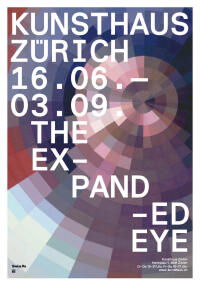The Expanded Eye. Das Sehen – entgrenzt und verflüssigt
16.06.2006 – 03.09.2006
Curated by Bice Curiger.
Location Pfister-Bau (Grosser Ausstellungssaal, ehem. Bührlesaal).
Curated by Bice Curiger.
Location Pfister-Bau (Grosser Ausstellungssaal, ehem. Bührlesaal).
Recourse to the Investigating Eye of Op Art
With ‘The Expanded Eye’ the curator Bice Curiger installed an ambitious exhibition in the large exhibition room of the Kunsthaus. Its title included a reference to the ‘Responsive Eye’ exhibition in New York’s MOMA, which, in 1965, had made Op Art known to the public. The show in Zurich had been preceded by a series of exhibitions which, after the rediscovery of Op Art by artists and museums in the 1990s, displayed experience-oriented light and sound art, including ‘Sons et lumières’ (Centre Pompidou, Paris 2004). ‘the eye is the dominant organ in our times, Our culture is a homage to visibility,’ wrote Bice Curiger in the catalog, although the constant expansion of our opportunities for perception also changed our view of reality. The unboundedness mentioned by Curiger in the title can be seen in this way. But liquefaction? Not really. Incidentally, the title also refers to the publication Expanded Cinema, where Gene Youngblood had analysed experimental film and video art and, for the first time, considered video a deserving artistic medium (Verlag Dutton, 1970).
About 100 positions were shown, and they exemplified the fact that with the new art forms the importance of the public had also been ‘discovered.’ They included artists active in the 1960s such as Salvador Dali, Marcel Duchamp, Josef Albers, Victor Vasarely, Henri Michaux, Nam June Paik, Andy Warhol and Jean Tinguely – and also Maya Deren as one of the few female video experimentalists. On the other hand, it was also possible to meet contemporary art-makers, such as Pipilotti Rist or Pierre Huyghe, for ‘expanded cinema’ also helped pave the way for today’s video and multimedia art. In a labyrinthine exhibition architecture, a total of 120 works could be seen, including paintings, kinetic objects, videos and films. Space was also found for Brian de Palma’s documentary film about the Responsive Eye exhibition (26 min., 1966).
The media’s response to the marathon show was broad and always positive. ‘Lust am explodierten Bildkosmos (Taking pleasure in the exploded picture cosmos) was the headline for a discussion by Barbara Basting in the Tages-Anzeiger, which found the show ‘extremely attractive as well as inspiring.’ Claudia Spinelli praised the absence of a chronology and the mixture of historic and contemporary points of view (Weltwoche). The exhibition was accompanied by a book-sized catalogue published by Hatje Cantz including essays by Ina Blom, Kurt Forster, Diedrich Diederichsen and others.
[Peter Stohler]
'Lust am explodierten Bildkosmos' (Taking pleasure in the exploded picture cosmos) was the headline for a discussion by Barbara Basting in the Tages-Anzeiger, which found the show 'extremely attractive as well as inspiring'.
79 days
70 Artists
70 Artists

exhibition poster
Image: Alex Brown
Image: Alex Brown